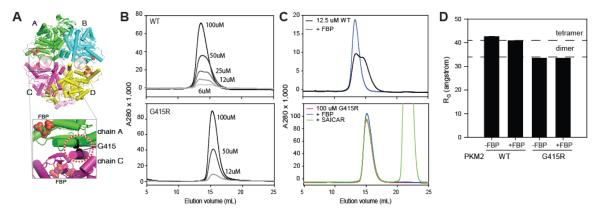Figure 1.
PKM2G415R is constitutively a dimer. (A) Structure of the PKM2 tetramer (PDB code 3ME3; (29)). The Cα of residue G415 is shown as a black sphere in each of the four chains. (B) PKM2WT (top) but not PKM2G415R (bottom) displays a concentration dependent gel-filtration elution changes. (C) FBP does not alter the oligomeric state of PKM2G415R. Gel filtration experiments show PKM2WT to have an FBP-dependent shift, whereas PKM2G415R was unaffected. (D) Small-angle X-ray scattering experiments suggest that PKM2G415R is constitutively a dimer. Values for the radius of gyration (Rg) of PKM2WT and PKM2G415R were calculated from Guiner plots, using scattering data taken with PKM2 in the presence and absence of FBP. For reference, the Rg values calculated from a PKM2 tetramer crystallographic structure (PDB code 3ME3, chains A-D) or a hypothetical dimer (chains A and B only) are shown as dashed lines.

